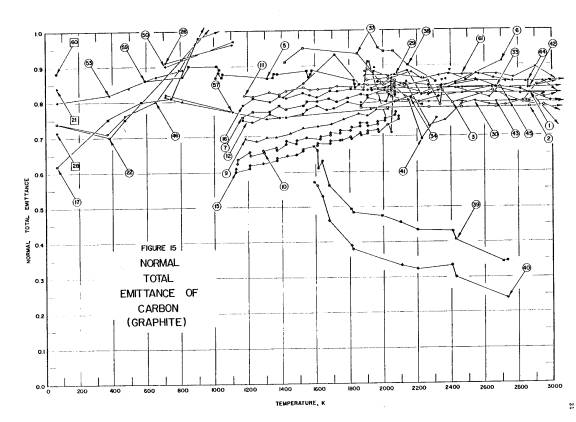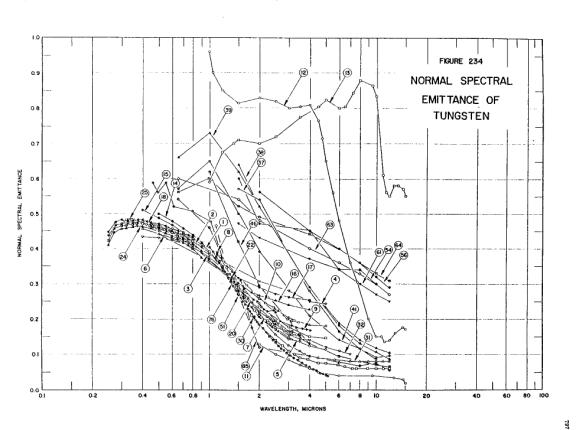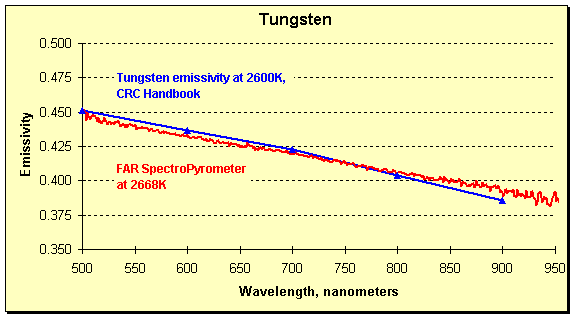About Emissivity
Emissivity — A property of a material, measured as the emittance of a specimen of the material that is thick enough to be completely opaque and has an optically smooth surface.
Emittance — …2. The ratio of the emitted radiant flux per unit area of a sample to that of a black body radiator at the same temperature and under the same conditions.
From the definitions above, emittance is the value needed for non-contact temperature measurement. The widespread use of the term emissivity instead may be a wistful usage, implying the hope that the emittance of one sample defines that of another of the same material. Unfortunately, the probabilities are against this. Whatever term is used, the value as it relates to pyrometry is not a property of a material, but of a particular sample. Key parameters affecting it are the surface finish, the chemical composition[1], the temperature, the sample’s thermal and mechanical history, and the wavelength at which the emissivity is desired. An excellent example is the graph reproduced below. It is the emissivity of graphite (we will use the popular term), one of the more common and better-known refractory materials, reported as a function of temperature[2].

The numbers associated with each trace describe the sample preparation and conditions for that measurement. The extreme variation of the values reported, from less than 0.3 to 0.99, shows that one should be reluctant to use any previously-measured value for emissivity for a temperature determination. Additionally, most samples show temperature dependence. Obviously, the conditions of the material and its environment affect the measurement. Conditions change for the simple reason the target is being processed. Because of this unavoidable change, we feel the only legitimate way to ensure accurate temperature measurement is to remove the dependence on emissivity from the measurement. This is what the SpectroPyrometer[3] was developed to do.
Relative emissivity
The relative emissivity, sometimes called the non-grayness or slope, is the parameter required by ratio pyrometers. It is defined as the ratio of the value of emissivity at the two wavelengths in question. Metals typically have a relative emissivity of other than one. An example is tungsten, perhaps the material whose radiation parameters have been most studied because of its application to lighting. The graph of tungsten’s emissivity as a function of wavelength is reproduced below[4].

As can be seen, besides varying with wavelength, the data scatters as a function of the conditions as set by various researchers (identified by the numbers associated with each plot).
To calculate the relative emissivity for a particular ratio pyrometer using information such as that above the following must be true:
- the conditions of the measurement must match an exact set of conditions reported;
- the conditions must not change during the measurement;
- the instrument’s response as a function of wavelength must be known for both “wavelengths” (really a range of wavelengths or a bandwidth).
Then the correct way to proceed would be to integrate the product of instrument bandwidth and the appropriate emissivity as a function of wavelength for both bandwidths, and use the resulting weighted emissivities to produce the desired ratio. It’s clear that this procedure is at best laborious; at worst, impossible.
The FAR SpectroPyrometer obviates the need for all that. Results from a single measurement of FAR’s SpectroPyrometer are shown in the graph below. The primary result is, of course, the temperature of the target, but a secondary result is the plot of target emissivity as a function of wavelength. The target was the tungsten filament of a quartz-halogen projection lamp operating at 60% of design current. For convenience of comparison, the spectral emissivity of tungsten at the closest temperature reported in tabular form[5] has been included on the same axes. The published data and the FAR results are in good agreement, providing external corroboration of the SpectroPyrometer’s unique capabilities.

See also emissivity of selected materials.
